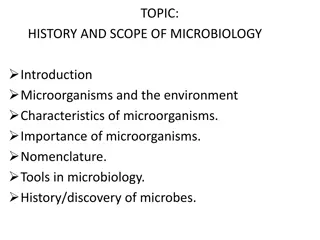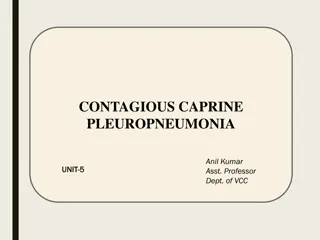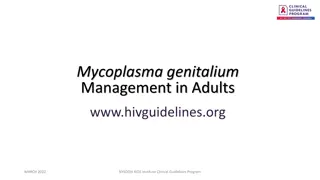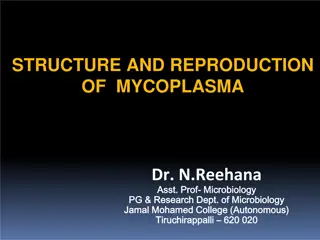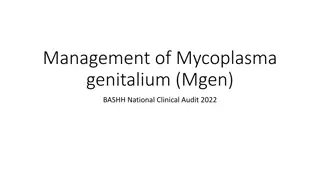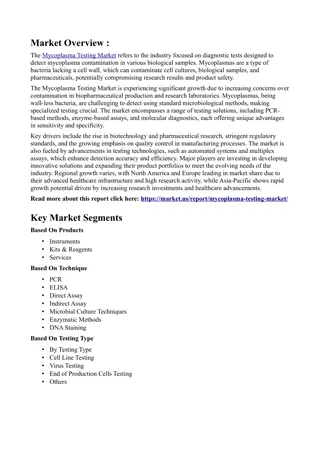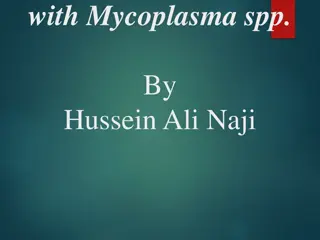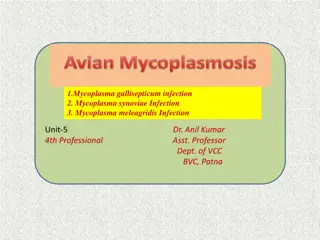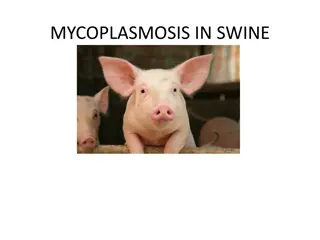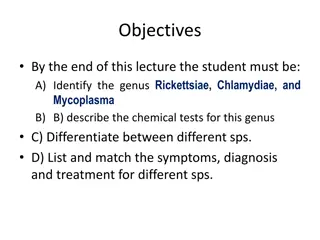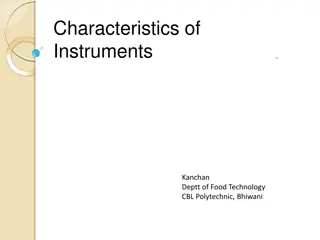Understanding Mycoplasma: Characteristics, History, and Impact
Mycoplasma, the smallest self-replicating bacteria, lack cell walls and pose challenges in research due to their contamination of cell cultures. Learn about their unique characteristics, historical background, differences from bacteria, Chlamydia, and viruses, and the importance of diagnosing and treating mycoplasma infections.
Download Presentation

Please find below an Image/Link to download the presentation.
The content on the website is provided AS IS for your information and personal use only. It may not be sold, licensed, or shared on other websites without obtaining consent from the author. Download presentation by click this link. If you encounter any issues during the download, it is possible that the publisher has removed the file from their server.
E N D
Presentation Transcript
LAYOUT INTRODUCTION HISTORY GENERAL CHARACTERISTICS GENOME TAXONOMIC CLASSIFICATION CULTURAL CHARACTERISTICS BIOCHEMICAL PROPERTIES ANTIGENIC PROPERTIES RESISTANCE PATHOGENESIS IMMUNITY EPIDEMIOLOGY SPECTRUM OF DISEASES LABORATORY DIAGNOSIS PROPHYLAXIS AND TREATMENT MYCOPLASMAS AS NORMAL FLORA
INTRODUCTION Mycoplasmas are the smallest and simplest self-replicating bacteria. The mycoplasma cell contains minimum set of organelles essential for growth and replication: a plasma membrane, ribosomes, and a genome consisting of a double-stranded circular DNA molecule. Unlike all other prokaryotes, the mycoplasmas have no cell walls, and they are consequently placed in a separate class Mollicutes(mollis, soft; cutis, skin).
CONTD. Mycoplasmas have been nicknamed the crabgrass of cell cultures. Contamination of cell cultures by mycoplasmas presents serious problems in research laboratories and in biotechnological industries using cell cultures. The origin of contaminating mycoplasmas is in components of the culture medium, particularly serum, or in the flora of the technician's mouth, spread by droplet infection.
DIFFERENCES BETWEEN MYCOPLASMAS, BACTERIA, CHLAMYDIA & VIRUSES CHARACTER MYCOPLASMA BACTERIA CHLAMYDIA VIRUSES SIZE 0.2-0.3 m - + 1-2 m 0.3 m 0.01-0.3 m - - CELL WALL + + + + PRESENCE OF BOTH DNA & RNA MULTIPLICATION IN CELL-FREE MEDIUM + + - - MULTIPLICATION DEPENDENT ON HOST NUCLEIC ACID - - - + CHOLESTEROL REQUIREMENT + + - - + - - INTRINSIC ENERGY METABOLISM + NARROW HOST RANGE + - - - + + - SENSITIVITY TO ANTIBIOTICS INHIBITING CELL WALL SYNTHESIS + SENSITIVITY TO ANTIBIOTICS INHIBITING PROTEIN SYNTHESIS + + + -
HISTORY The name Mycoplasma is derived from the Greek word mykes (fungus) and plasma (formed) [Mycos :Fungus like form of branching filaments & Plasma :Denoting plasticicity of their shape].It was first used by Albert Bernhard Frank in 1889. He thought it was a fungus, due to fungus-like characteristics. An older name for Mycoplasma was Pleuropneumonia-Like Organisms (PPLO), referring to organisms similar to the causative agent of contagious bovine pleuropneumonia (CBPP).It was later found that the fungus-like growth pattern of M. mycoides is unique to that species.
CONTD. In 1898 Nocard and Roux reported the cultivation of the causative agent of CBPP, which was at that time a grave and widespread disease in cattle herds. The disease is caused by M. mycoides subsp. mycoides .
CONTD. Eaton in 1944 was the first to isolate the causative agent of PAP(Primary Atypical Pneumonia) in hamsters and cotton rats. He was able to transmit the infection later to chick embryos by amniotic inoculation. Because it was filterable, it was considered to be a virus(Eaton agent), but was subsequently shown to be a mycoplasma and named Mycoplasma pneumoniae.
GENERAL CHARACTERISTICS Very small(0.2-0.3 m) . Can pass through bacterial filters. Lack a rigid cell wall. Bound by a single trilaminar cell membrane that contains a sterol. Extremely pleomorphic varying in shape from coccoid to filamentous to other bizzare forms.
ELECTRONMICROGRAPHOFTHIN-SECTIONEDMYCOPLASMA CELLS Cells are bounded by a single membrane showing in section the characteristic trilaminar shape. The cytoplasm contains thin threads representing sectioned chromosome and dark granules representing ribosomes. (Courtesy of RM Cole, Bethesda, Maryland).
CONTD. Mycoplasma, Ureaplasma, Spiroplasma and Anaeroplasma cannot synthesize their own cholesterol and require it as a growth factor in culture medium. Acholeplasma synthesizes carotenol as a substitute for cholesterol, but will incorporate cholesterol if it is provided. Insensitive to cell-wall active antibiotics such as penicillins and cephalosporins. Limited biosynthetic capabilities due to a small genome.
CONTD. Multiply by binary fission. However, cytoplasmic division may lag behind genome division. This results in the formation of multinucleate filaments and other shapes. Do not possess flagellae or pili Non sporing Stain poorly with Gram stain. Can be stained with Giemsa and Dienes methods. Are considered as stable L forms by some researchers but this hypothesis is still not fully accepted.
CONTD Cells may either divide by binary fission or first elongate to multinucleate filaments, which subsequently breakup to coccoid bodies. From Razin S: Mycoplasmas: the smallest pathogenic procaryotes. Isr J Med Sci 17:510, 1981, with permission.
CONTD. Membrane proteins & glycolipids exposed on the cell surface are the major antigenic determinants in mycoplasmas. Antisera containing antibodies to these components inhibit growth and metabolism of the mycoplasmas and, in the presence of complement, cause lysis of the organisms. These properties are used in various serologic tests that differentiate between mycoplasma species and serotypes and detect antibodies to mycoplasmas in sera of patients.
CONTD. Some mycoplasmas possess unique attachment organelles, which are shaped as a tapered tip in M. pneumoniae and M. genitalium. Mycoplasma pneumoniae is a pathogen of the respiratory tract, adhering to the respiratory epithelium, primarily through the attachment organelle. Interestingly, these two human mycoplasmas exhibit gliding motility on liquid-covered surfaces. The tip structure always leads, again indicating its importance in attachment. One of the most useful distinguishing features of mycoplasmas is their peculiar fried-egg colony shape, consisting of a central zone of growth embedded in the agar and a peripheral one on the agar surface.
GENOME The mycoplasma genome is typically prokaryotic, consisting of a circular, double stranded DNA molecule. The Mycoplasma and Ureaplasma genomes are the smallest recorded for any self-reproducing prokaryote. In some mycoplasmas the number is estimated at fewer than 500, about one sixth the number of genes in Escherichia coli. Mycoplasmas accordingly express a small number of cell proteins and lack many enzymatic activities and metabolic pathways. Their nutritional requirements are correspondingly complex, and they are dependent on a parasitic mode of life.
TAXONOMIC CLASSIFICATION Kingdom : Bacteria Phylum : Firmicutes Class: Mollicutes(mollis: soft and cutis: skin) Orders: Entomoplasmatales(plants & insects) Mycoplasmatales Acholeplasmatales (birds & animals) Anaeroplasmatales( cattle & birds)
CONTD. FAMILIES: Entomoplasmataceae & Spiroplasmataceae( order: Entomoplasmatales) Mycoplasmataceae( order: Mycoplasmatales) Acholeplasmataceae(order: Acholeplasmatales) Anaeroplasmataceae(order: Anaeroplasmatales)
CONTD. Family Mycoplasmataceae has two genera: Mycoplasma( approx.100 species) & Ureaplasma (6 species). Family Acholeplasmataceae has only one genus, Acholeplasma which comprises 10 species of which one species A.laidlawii may be found from the specimens of human oral cavity, respiratory tract and genital tract. Spiroplasmataceae(Genus: Spiroplasma) & Anaeroplasmataceae(Genus: Anaeroplasma).
CULTURAL CHARACTERISTICS Aerobes and facultative anaerobes except Anaeroplasma which is strictly anaerobic. For primary isolation, an atmosphere of 95% Nitrogen and 5% Carbon dioxide is preferred. They can grow within a temperature range of 22-41 C, the parasitic species growing optimally at 35-37 C. For fermentative organisms, the initial pH of the medium is adjusted to 7.3-7.8, for arginine metabolizing organisms it should be around 7 and for ureaplasmas, range of pH should be 6-6.5.
CONTD. The dependence of mycoplasmas on their host for many nutrients explains the great difficulty of cultivation in the laboratory. The complex media for mycoplasma culture contain serum, which provides fatty acids and cholesterol for mycoplasma membrane synthesis. The requirement of most mycoplasmas for cholesterol is unique among prokaryotes. The consensus is that only a small fraction of mycoplasmas existing in nature have been cultivated so far.
CONTD. Some of the cultivable mycoplasmas, including the human pathogen M pneumoniae, grow very slowly, particularly on primary isolation. Ureaplasma urealyticum, a pathogen of the human urogenital tract, grows very poorly in vitro, reaching maximal titers of 107organisms/ml of culture. Mycoplasma genitalium, another human pathogen, grows so poorly in vitro that only a few successful isolations have been achieved.
MEDIA PPLO broth: Bovine heart infusion broth to which are added 20% horse serum and 10% fresh yeast extract along with glucose and phenol red as a pH indicator. Growth of M.pneumoniae is detected by turbidity and colour change(red to yellow) of phenol red indicator, due to fermentation of glucose. Ureaplasma and other mycoplasmas which do not ferment glucose show only turbidity. This medium can be solidified by the addition of agar. Penicillin, polymyxin B and amphotericin B may be added to inhibit contaminating bacteria and fungi respectively.
CONTD. Since thallium acetate is inhibitory for U. urealyticum and M. genitalium and highly poisonous for humans, therefore, it should not be added to the medium. A diphasic medium in screw-capped bottle containing an agar phase that is overlaid with broth medium of similar composition may also be used. SP-4 medium: Basal medium( Mycoplasma broth base, tryptone, peptone, glucose, deionized water) + supplements( CMRL 1066 cell or tissue culture medium, 10X concentrate with glutamine, 25% solution of fresh yeast extract, 2% solution of yeast olate, fresh bovine serum heated at 56 C for 1 hour, penicillin 100,000 units/ml, phenol red solution, 0.1% w/v).
COLONIES Incubation: 2-6 days. Media for isolation of genital mycoplasmas and M. pneumoniae should be incubated for 1 and 4 weeks respectively, before a final culture report is made. Size: 200-500 m for mycoplasmas and 15-60 m for ureaplasmas. The colonies of Ureaplasma are extremely small and thus Ureaplasma are also called T-strains (tiny strains). Platinum loops: Can t be picked up. Subculture is done by cutting out an agar block with colonies and rubbing it on fresh plates.
DIENES STAIN Contains azure II, methylene blue, Na2CO3, benzoic acid and distilled water. The plate containing suspected Mycoplasma colonies is flooded with Dienes stain diluted 1 in 10 in water. It is then immediately rinsed with distilled water to remove the stain. The medium is decolorized by adding 1ml of 95% ethanol for 1 minute and then removed. The wash step is repeated second time, rinsed with distilled water and allowed to dry. The colonies are then observed under low power of a microscope.
CONTD. Mycoplasmas with the FRIED EGG COLONY morphology appear highly granular and stain with a dark blue centre and a light blue periphery. The agar background appears clear or slightly violet. Mycoplasmas other than M. pneumoniae remain stained, but M.pneumoniae reduces the methylene blue after a period and becomes colourless.
BIOCHEMICAL PROPERTIES Glucose and other metabolizable carbohydrates can be used as energy sources by the fermentative mycoplasmas possessing the Embden-Meyerhof-Parnas glycolytic pathway. Oxidative phosphorylation does not occur as an ATP-generating mechanism.
CONTD. Breakdown of arginine by the arginine dihydrolase pathway has been proposed as a major source of ATP in nonfermentative mycoplasmas. Ureaplasmas have a requirement, unique among living organisms, for urea. Because they are non-glycolytic and lack the arginine dihydrolase pathway, it has been suggested, and later proven experimentally, that ATP is generated through an electrochemical gradient produced by ammonia liberated during the intracellular hydrolysis of urea by the organism's urease.
BIOCHEMICAL REACTIONS SPECIES GLUCOSE ARGININE UREA M. pneumoniae + - - M. salivarium - + - M. orale - + - M. hominis - + - U. urealyticum - - + M. fermentans + + - M. genitalium + - - A. laidlawii + - -
ANTIGENIC PROPERTIES: Surface Antigens: Made up of Glycolipids and proteins. Glycolipids antigens are identified by complement fixation test. Glycolipids with similar antigenic structure have been found in human brain. Protein antigens - ELISA. Growth inhibition Test: Particular technique useful for the identification of isolates based on the ability of antisera to specifically inhibit the growth of the homologous species on solid media.
RESISTANCE: Destroyed at 450C in 15 min. Resistant to lysis by Osmotic shock, penicillin and Cephalosporins. Sensitive: To Surface acting agents, lipolytic agents(taurocholate, digitonin), Tetracyclines, Erythromycin. Susceptibility to Macrolide antibiotics and erythromycin is used for species differentiation. Growth is inhibited by Gold salts. They( M. pneumoniae)can grow in presence of 0.002% methylene blue in agar while other species are inhibited.
CONTD. Most mycoplasmas that infect humans and other animals are surface parasites, adhering to the epithelial linings of the respiratory and urogenital tracts. Adherence is firm enough to prevent the elimination of the parasites by mucous secretions or urine. The intimate association between the adhering mycoplasmas and their host cells provides an environment in which local concentrations of toxic metabolites excreted by the parasite build up and cause tissue damage .
CONTD. Moreover, because mycoplasmas lack cell walls, fusion between the membranes of the parasite and host has been suggested, and some experimental evidence for it has recently been obtained. Membrane fusion would alter the composition and permeability of the host cell membrane and enable the introduction of the parasite's hydrolytic enzymes into the host cell, events expected to cause serious damage. Recent studies have indicated the presence in mycoplasmas of antigenic variability systems. These systems, some of which are already defined in molecular genetic terms, are responsible for rapid changes in major surface protein antigens. The change in the antigenic coat of the parasite helps it to escape recognition by the immune mechanisms of the host.
CONTD. A. Adherence factors The adherence proteins are one of the major virulence factors. The adherence protein in M. pneumoniaehas been identified as a 168kDa protein called P1. The P1 adhesin localizes at tips of the bacterial cells and binds to sialic acid residues on host epithelial cells. MgPa is a similar adherence protein in M. genitalium. The nature of the adhesins in the other species has not been established. Colonization of the respiratory tract by M. pneumoniae results in the cessation of ciliary movement. The normal clearance mechanisms of the respiratory tract do not function, resulting in contamination of the respiratory tract and the development of a dry cough.
CONTD. Transmission electron photomicrographs of the specialized tip organelle of cytadherence-positive M. pneumoniae demonstrating: a) Truncated structure with nap. b) Clustering of cytadherence- related proteins (P1, B, C, P30) at the tip based on immunolabeling with ferritin and colloidal gold and crosslinking studies. c) Triton X-100-resistant, cytoskeleton-like, structure with distinct bleb and parallel filaments
TRANSMISSIONELECTRONPHOTOMICROGRAPHOFA HAMSTERTRACHEARINGINFECTEDWITH M. PNEUMONIAE. M, MYCOPLASMA; M, MICROVILLUS; C, CILIA.
CONTD. B. Toxic Metabolic Products o The intimate association of the mycoplasma and the host cells provides an environment in which toxic metabolic products accumulate and damage host tissues. o Both hydrogen peroxide and superoxide, which are products of mycoplasma metabolism, have been implicated in pathogenesis since oxidized host lipids ( like malonyldialdehyde) have been found in infected tissues. o Furthermore, the mycoplasmas have been shown to inhibit host cell catalase by excreting superoxide radicals ( O2 ), thereby increasing the peroxide concentrations.
CONTD. C. Immunopathogenesis o Mycoplasmas can activate macrophages and stimulate cytokine production and lymphocyte activation (M. pneumoniae is a superantigen). Thus, it is has been suggested that host factors also contribute to pathogenesis. o Experimental evidence in animals supports this suggestion. Ablation of thymus function before infection with M. pneumoniae prevents the development of pneumonia and animals in which thymic function is restored develop pneumonia at an exacerbated rate.
CONTD. Epidemiologic data in humans suggest that repeated infections are required before clinical disease is observed, again suggesting a role for host related factors in pathogenesis. Most children are infected from 2 - 5 years of age but disease is most common in children 5-15 years of age.
CONTD. Recently, M. pneumoniae has been shown to produce an exotoxin that is also believed to play a major role in the damage to the respiratory epithelium that occurs during acute infection. This toxin, named the community-acquired respiratory disease toxin (CARDS) is an ADP-ribosylating and vacuolating cytotoxin similar to pertussis toxin. Evidence from animal models of M. pneumoniae infection have proven that recombinant CARDS toxin results in significant pulmonary inflammation, release of proinflammatory cytokines, and airway dysfunction.
CONTD. Variation in CARDS toxin production among M. pneumoniae strains may be correlated with the range of severity of pulmonary disease observed among patients. The organism also has the ability to exist and possibly replicate intracellularly, which may contribute to chronicity of illness and difficult eradication. Additionally, acute mycoplasmal respiratory tract infection may be associated with exacerbations of chronic bronchitis and asthma.
CONTD. An immunopathologic mechanism also may explain the complications affecting organs distant from the respiratory tract in some patients infected with M. pneumoniae. Various autoantibodies have been detected in the sera of many of these patients, including cold agglutinins reacting with the erythrocyte I antigen, and antibodies reacting with lymphocytes, smooth muscle cells, and brain and lung antigens. Serologic cross-reactions between M. pneumoniae and brain and lung antigens have been demonstrated, and these antigens are probably related to the glycolipids of M. pneumoniae membranes, which are also found in most plants and in many bacteria. Clearly, host reaction varies markedly, as only about half of the patients develop cold agglutinins and complications are rare, even among individuals with anti-tissue globulins.
IMMUNITY Complement activation via the alternative pathway and phagocytic cells both play a role in resistance to infection. As the infection proceeds, antibodies play a role in controlling infection, particularly IgA. The development of delayed type hypersensitivity, however, is associated with the severity of the disease, which supports the suggestion that pathogenesis is at least, in part, immunopathogenesis.
EPIDEMIOLOGY All mycoplasmas cultivated and identified thus far are parasites of humans, animals, plants, or arthropods. The primary habitats of human and animal mycoplasmas are the mucous surfaces of the respiratory and urogenital tracts and the joints in some animals. Although some mycoplasmas belong to the normal flora, many species are pathogens, causing various diseases that tend to run a chronic course.
CONTD. Pneumonia caused by M. pneumoniae occurs worldwide and no increased seasonal activity is seen. Epidemics occur every 4 - 8 years. Studies have indicated that M. pneumoniae is second only to Streptococcus pneumoniae as a cause of bacterial pneumonia that requires hospitalization in elderly adults. Subclinical infections may occur in 20% of adults infected with Mycoplasma pneumoniae, suggesting that some degree of immunity may contribute to the failure of appearance of clinical symptoms in some instances. Recent evidence suggests that M. pneumoniae disease is sometimes much more severe than appreciated, even in otherwise healthy children and adults. Severe disease is more common in persons with underlying disease or immunosuppression. The overall mortality rate is extremely low, probably less than 0.1%.


